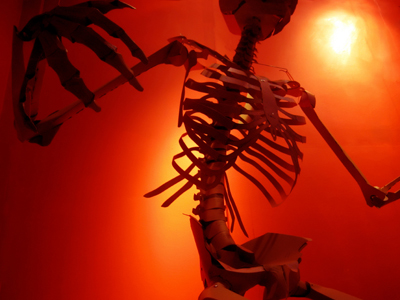

Where would we be without our bones?
Basic Anatomy - The Skeleton
This Science quiz is called 'Basic Anatomy - The Skeleton' and it has been written by teachers to help you if you are studying the subject at middle school. Playing educational quizzes is a fabulous way to learn if you are in the 6th, 7th or 8th grade - aged 11 to 14.
It costs only $19.50 per month to play this quiz and over 3,500 others that help you with your school work. You can subscribe on the page at Join Us
The skeleton is the bone structure within the body that supports the body and allows it to withstand movement. It also produces blood cells and stores minerals. When a person is born, they have a total of 270 different bones. However, as a person grows, many of those bones fuse together so that by late childhood/early adulthood the bone total drops to 206.
Skull: The skull protects the brain and supports the soft tissue of the head. (It contains 22 bones.)
Maxilla: The maxilla is an irregular shaped bone that makes up the upper portion of the jaw.
Mandible: The mandible is also known as the jaw bone.
Clavicle: The clavicle is also known as the collarbone. It consists of a pair of long bones that connect the scapula to the sternum.
Vertebra: The vertebra is also known as the spinal column.
Scapula: The scapula is also known as the shoulder blade and it articulates with the humerus. It is a triangular, flat bone.
Sternum: The sternum is also known as the breastbone. It is a long, narrow and flat bone that is the keystone to the rib cage. It also helps to stabilize the thoracic skeleton.
Ribs: The ribs are long curved bones which form a cage that protects the organs found in the chest.
Humerus: The humerus is the largest bone in the upper part of the arm. Radius: The radius is the shorter of two long bones that are found in the lower part of the arm.
Pelvis: The pelvis is the bone that connects the base of the spine with the legs.
Ulna: The ulna is the longer of the two bones that are found in the lower part of the arm.
Sacrum: The sacrum is part of the vertebra. It is wedge shaped and rests at the end of the spine where it intersects with the hip bones to form the pelvis.
Metacarpals: The metacarpals make up the knuckles on the hands.
Phalanges: Phalanges are the bones that exist in each finger and each toe. In total, there are 56 phalanges with 14 in each hand.
Femur: The femur is the thigh bone and it is the longest, strongest and heaviest bone of the human body.
Patella: The patella is also known as the kneecap.
Tibia: The tibia is also known as the shin bone. The lower half of the leg contains two long bones. The tibia is the thicker of the two where the fibula is the thinner.
Fibula: The fibula is a long, thin bone of the lower half of the leg. It runs parallel to the tibia.
Tarsals and Metatarsals: Tarsals and metatarsals are bones found in the foot.
Well, that was quite a list of the bones. Take some time to study this list carefully and see if you can locate the bones on your own body. Then when you feel like you can name each bone successfully, move on to the ten questions below and see how many of them you can find the right answer for.
Ready for more?
not all...
quizzers. Try to win a coveted spot on our Hall of Fame Page.






